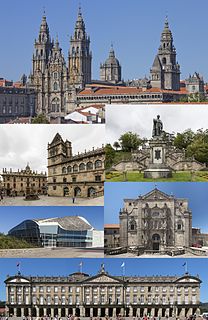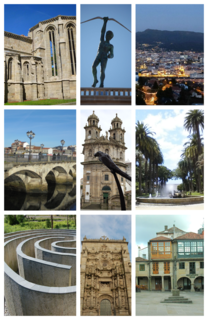
Galicia is an autonomous community of Spain and historic nationality under Spanish law. Located in the northwest Iberian Peninsula, it includes the provinces of A Coruña, Lugo, Ourense and Pontevedra.

Santiago de Compostela is the capital of the autonomous community of Galicia, in northwestern Spain. The city has its origin in the shrine of Saint James the Great, now the Cathedral of Santiago de Compostela, as the destination of the Way of St. James, a leading Catholic pilgrimage route since the 9th century. In 1985, the city's Old Town was designated a UNESCO World Heritage Site.

In Spain, an autonomous community is a first-level political and administrative division, created in accordance with the Spanish Constitution of 1978, with the aim of guaranteeing limited autonomy of the nationalities and regions that make up Spain.

Pontevedra is a Spanish city in the north-west of the Iberian Peninsula. It is the capital of both the Comarca (County) and Province of Pontevedra, and of the Rias Baixas in Galicia. It is also the capital of its own municipality which is, in fact, often considered as an extension of the actual city.

Vigo is a city and municipality in the province of Pontevedra, within the autonomous community of Galicia, Spain. Located in the northwest of the Iberian Peninsula, it sits on the southern shore of an inlet of the Atlantic Ocean, the Ria de Vigo, the southernmost of the so-called Rías Baixas.

A Coruña is a city and municipality of Galicia, Spain. A Coruña is the most populated city in Galicia and the second most populated municipality in the autonomous community and seventeenth overall in the country. The city is the provincial capital of the province of the same name, having also served as political capital of the Kingdom of Galicia from the 16th to the 19th centuries, and as a regional administrative centre between 1833 and 1982, before being replaced by Santiago de Compostela.
The Xunta de Galicia is the collective decision-making body of the government of the autonomous community of Galicia, composed of the President, the Vice-President(s) and the specialized ministers (Conselleiros).

The City of Culture of Galicia is a complex of cultural buildings in Santiago de Compostela, Province of A Coruña, Galicia, Spain, designed by a group of architects led by Peter Eisenman. Construction was challenging and expensive as the design of the buildings involves high degree contours, meant to make the buildings look like rolling hills. Nearly every window of the thousands that are part of the external façade has its own custom shape. In 2013 it was announced that after more than a decade, construction of the project would be halted. The International Art Center and Music and Scenic Arts Center will not be built.

The University of Santiago de Compostela - USC is a public university located in the city of Santiago de Compostela, Galicia, Spain. A second campus is located in Lugo, Galicia. It is one of the world's oldest universities in continuous operation.

The Statute of Autonomy of Galicia of 1981 is the current basic institutional norm of Galicia. The Galician Government, Parliament and High Court of Galicia are regulated by it.

A parroquia is a population entity or parish found in Galicia and Asturias in north-west Spain. They are entities with a territorial scope lower than municipality and have their own legal personality. They usually, but not always, coincide with the ecclesiastic divisions as they originated on pair with them.
La Voz de Galicia is a Spanish daily newspaper owned by the Corporación Voz de Galicia. La Voz is highest circulation newspaper in Galicia and the eighth-highest circulation general-interest daily newspaper in Spain. It is written primarily in Spanish with Galician used in the cultural and opinion sections.

Galicians are a Romance ethnic group, closely related to the Portuguese people, and whose historic homeland is Galicia, in the north-west of the Iberian Peninsula. Two Romance languages are widely spoken and official in Galicia: the native Galician and Spanish.

Spain is a diverse country integrated by contrasting entities with varying economic and social structures, languages, and historical, political and cultural traditions. According to the current Spanish constitution, the Spanish nation is the common and indivisible homeland of all Spaniards, composed of nationalities and regions which the constitution recognizes and guarantees the right of self-government.

Both the perceived nationhood of Spain, and the perceived distinctions between different parts of its territory are said to derive from historical, geographical, linguistic, economic, political, ethnic and social factors.

Galician nationalism is a form of nationalism found mostly in Galicia, which asserts that Galicians are a nation and that promotes the cultural unity of Galicians. The political movement referred to as modern Galician nationalism was born at the beginning of the twentieth century from the idea of Galicianism.

The Rexurdimento was a period in the History of Galicia during the 19th century. Its central feature was the revitalization of the Galician language as a vehicle of social and cultural expression after the so-called séculos escuros in which the dominance of Castilian Spanish was nearly complete. The Galician Rexurdimento coincides with the Catalan Renaixença.

The political division of the Kingdom of Spain is defined in Part VIII of the Spanish constitution of 1978, which establishes three levels of territorial organization: municipalities, provinces and autonomous communities, the first group constituting the subdivisions of the second, and the second group constituting the subdivisions of the last. The State guarantees the realization of the principle of solidarity by endeavouring to establish an economic balance between the different areas of the Spanish territory.

The 2012 Galician regional election was held on Sunday, 21 October 2012, to elect the 9th Parliament of the autonomous community of Galicia. All 75 seats in the Parliament were up for election. The election was held simultaneously with a regional election in the Basque Country.
There is a variety of Vernacular languages spoken in Spain. Spanish, the official language in the entire country, is the predominant native language in almost all of the autonomous communities in Spain. Six of the seventeen autonomous communities in Spain have other co-official languages in addition to Spanish. Bilingualism in different degrees and in distinct communicative situations between Spanish and another language is a habitual practice for many of the Spanish people who reside in one of these autonomous communities.

















